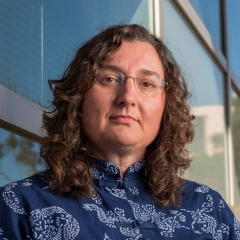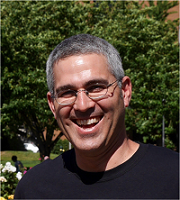

Thursday, December 10, 3:30pm - 4:30pm, ZOOM 
Postdoctoral Fellow, International Institute for Nanotechnology
Northwestern University
PhD Stanford, 2019 (Zare)
I design and synthesize nanoscale soft materials for biological and medical applications. As a graduate student, I developed approaches for controlled drug release using electric-stimuli responsive polymeric nanoparticles. My research laid the foundation for building the first acoustically-powered, minimally-invasive, electroresponsive drug delivery platform. During my postdoctoral training, I have been developing DNA-based nanostructures as dynamic material building blocks and chemical probes for live-cell analysis. These structures are highly tailorable and can be used for studying fundamental biological processes, detecting diseases early, and screening drugs in high throughput.
Publications (Google Scholar Citations)
ORCID: https://orcid.org/0000-0002-0647-7673
h-index: 13 Total Citations: 530 (Google Scholar Citations, Nov. 2020)
Monday, November 30, 3:30pm - 4:30pm, ZOOM
Postdoctoral Researcher
UC Berkeley
PhD Caltech, 2019 (Nathan Lewis)
Sustainable energy practices require electrochemical materials to couple renewable energy sources with our chemical and energy industries. This talk will focus on advancements in both the discovery of new electrochemical materials with improved performance and the development of new techniques to observe electrochemical reaction dynamics. We will first discuss the discovery of an earth-abundant class of electrocatalysts that are thermodynamically stable for the oxygen evolution and chlorine evolution reactions in acidic electrolytes. Our discussion will then focus on the development of electrochemical graphene liquid cell electron microscopy, a technique that allows electrochemical reactions to be observed at near-atomic resolution in real time.
Publications (Google Scholar Citations)
ORCID: https://orcid.org/0000-0001-6461-9214
h-index: 6 Total Articles: 8 Total Citations: 146 (Web of Science, Nov. 2020)
h-index: 6 Total Citations: 178 (Google Scholar Citations, Oct. 2020)
Inorganic and A&P Seminar
Thursday, October 22, 3:30pm - 4:30pm, ZOOM
Assistant Professor
University of Michigan
Abstract: One of the primary barriers to the large-scale implementation of intermittent renewable energy sources such as solar and wind is effective energy storage. The selective electrochemical reduction of CO2 in the CO2 reduction reaction (CO2RR) is a crucial strategy for storing energy from intermittent energy sources in the form of chemical bonds (e.g. solar fuels). Current state-of-the-art solid-state catalyst materials produce useful products such as methanol or ethylene, but typically do so non-selectively with a variety of gaseous and liquid products including H2 from competitive water reduction. Alternatively, molecular catalysts show promise for more selective reduction of CO2 to single products, typically CO or formic acid, but usually perform with lower overall activity compared to solid-state analogues. My research group is focused on the development of new catalytic systems that reduce CO2 with the selectivity of molecular catalysts but operate with the activity of solid-state catalytic materials.
In this talk, I will present some of our recent studies exploring the use of polymer encapsulation to control the chemical environment surrounding molecular electrocatalysts in order to increase catalytic activity and selectivity for the CO2RR. In particular, I will demonstrate that encapsulating cobalt phthalocyanine (CoPc), a mediocre CO2RR catalyst, within an encapsulating polyvinylpyridine polymer leads to a dramatic increase in the activity and selectivity for the CO2RR. Using a combination of electroanalytical and spectroelectrochemical approaches, I will illustrate how the encapsulating polymer surrounding the CoPc center modulates the primary, secondary, and outer coordination sphere of the catalysts, and I will discuss how modifying these coordination spheres has profound impacts on the catalytic activity, reaction selectivity, and mechanism of CO2 reduction.
Publications (Google Scholar Citations)
h-index: 18 Total Citations: 6626 (Google Scholar Citations, Oct. 2020)
Department Seminar
Wednesday, October 14, 3:30pm - 4:30pm, ZOOM
Professor
University of California Santa Barbara
The Scott group conducts both fundamental and applied research in reactions, surface chemistry, and catalysis. Our goal is to understand the interactions and transformations of molecules at gas-solid and liquid-solid interfaces by creating highly uniform active sites. We use advanced techniques in organometallic and coordination chemistry, surface science, spectroscopy, kinetics, mechanistic analysis and modeling to investigate, design and reengineer heterogeneous catalysts. Our group includes both chemical engineering and chemistry students, working to solve important current problems at the interface of chemistry and reaction engineering.
Publications (Google Scholar Citations)
h-index: 48 Total Citations: 6600 (Google Scholar Citations, Oct. 2020)
Wednesday, September 30, 3:30pm - 4:30pm, ZOOM
Assistant Professor
University of Chicago
Abstract. Transition metal oxo complexes, particularly those of later transition metals, have been cited as important intermediates in processes such as C-H hydroxylation and oxygen evolution. In general, however, these species are highly reactive and difficult to isolate and study. In this talk I will present our laboratory’s efforts at isolating and studying late transition metal oxo complexes. We have found that use of pseudo-tetrahedral geometries enables the isolation of an unusual terminal Co-oxo complex. The reactivity of this species towards C-H activation is markedly different than that observed for the majority of other systems and provides experimental evidence for a new mechanistic scenario dubbed "asynchronous" CPET. Finally, the possible relevance of related Co and Ni complexes in this system towards O-O bond formation will be discussed.
h-index: 13 Total Articles: 32 Total Citations: 1157 (Web of Science, Sep. 2020)
HHMI Seminar
Wednesday, September 2, 3:30pm - 4:30pm, ZOOM
Associate Professor
Texas Christian University
Abstract. Alzheimer’s and other neurodegenerative diseases are chronic conditions affecting millions of individuals worldwide. Although neurodegenerative diseases differ in the symptoms exhibited, oxidative stress is a consistent component described in the development of these brain-based diseases. Despite efforts that have shown promise of regulating oxidative stress in preventing or treating other diseases, there still remains a great need to produce new therapeutic molecules capable of affecting neurodegenerative diseases that involve oxidative stress and to develop an understanding of the activities observed. Therefore, innovative strategies to develop drug candidates that overcome oxidative stress in the brain are needed. To target these challenges, a new, water soluble pyridinophane 12-membered tetra-azamacrocycle L4 was designed and produced using a building block approach. L4 was shown to have dramatically enhanced antioxidant activity and increased biological compatibility in a neuronal cell line compared to parent molecules reported previously. Moreover, L4 was determined to have positive pharmacological characteristics such as an ideal pI = 7.4 and high metabolic stability in Phase I &II models. The Cu(II) complex of L4 was evaluated by X-ray diffraction and cyclic voltammetry to show the modes of antioxidant activity derived from a number of assays. As such, L4 shows how improvement of lead compounds has potential for the treatment for neurodegenerative diseases where oxidative stress plays a substantial role.
Publications (Google Scholar Citations)
h-indes: 16 Total Citations: 1213 (Google Scholar Citations, Aug. 2020)
Wednesday, March 4, 3:30pm - 4:30pm, WEL 2.122
Assistant Professor
Utah State University
Abstract: In response to rapidly increasing energy storage demands of consuming electronics, electrical vehicles, electrical grids, and renewable energy integration, there is an urgent call for advanced rechargeable batteries with superior energy storage performance and more affordable material costs compared to existing battery technologies. The first part of this presentation will cover our recent effort in developing new battery chemistries towards sustainable and economical electrochemical energy storage. Through rational molecular engineering, we have designed and applied redox active molecules including viologen (anolyte), quinone (anolyte), TEMPO (catholyte), ferrocene (catholyte), and ferrocyanide (catholyte) for developing aqueous organic redox flow batteries (AORFBs). The chemistry and battery performance of redox active molecules will be discussed in detail. In addition, extended from our RFB project, we have employed redox active molecules as electrocatalysts for both energy and chemical conversions. In the second part of this presentation, I will share our recent success in developing Ni-catalyzed electrochemical C-C bond cross-coupling reactions with good reaction efficiency and practical applications while only using bench stable substrates and catalysts. Particularly, this presentation emphasizes that in-depth mechanistic understandings of redox active molecules play crucial roles in developing advanced organic redox flow batteries and electrocatalysis methodologies.
Publications (Google Scholar Citations)
h-index: 29 Total Articles: 56 Total Citations: 2646 (Web of Science, Feb. 2020)
h-indes: 31 Total Citations: 3499 (Google Scholar Citations, Feb. 2020)
Wednesday, February 26, 1:30pm - 2:30pm, WEL 2.122
Professor in Structural Chemistry and Biology
Massey University (New Zealand)
Abstract: The canonical mechanism posits that the oxidation of superoxide and concomitant reduction of the Mn or Fe centre of Mn and Fe superoxide dismutases (SODs) is accompanied by protonation of a metal-coordinated hydroxide ligand. We have accumulated a swathe of evidence, including 0.90-Å structures, suggesting that, at least in the case of MnSOD, the active site is constructed to avoid such protonation. This has implications into the origin of metal specificity in Mn and FeSODs. In probing the mechanism of proton-coupled electron transfer, by mutating residues in the canonical dimer interface, we have “evolved” a new tertiary and quaternary structure with just one mutation.
Publications (Google Scholar Citations)
ORCID: https://orcid.org/0000-0003-4839-0784
h-index: 51 Total Articles: 279 Total Citations: 8643 (Web of Science, Feb. 2020)
h-indes: 50 Total Citations: 7822 (Google Scholar Citations, Feb. 2020)
Wednesday, February 5, 3:30pm - 4:30pm, WEL 2.122
Nicole A. Boand Endowed Chair Professor of Chemistry
University of Washington
Abstract: Nanoscale semiconductors play central roles in many current and next-generation photonic and energy technologies. This talk will describe some recent advances from our group in the synthesis and spectroscopic study of inorganic nanocrystals displaying unique physical properties that may define their future technological potential. A central goal of this research pertains to harnessing the power of impurities or other defects to control the physical properties of many inorganic crystals, a control that most semiconductor technologies including transistors, diodes, and solar cells rely upon. Other interesting physical characteristics including emergent magnetic properties resulting will be described, and potential applications of these materials particularly for solar spectral conversion will be discussed.
Publications (Google Scholar Citations)
h-index: 67 Total Articles: 197 Total Citations: 16,922 (Web of Science, Jan. 2019)
h-index: 72 Total Citations: 20,816 (Google Scholar Citations, Jan. 2020)
Wednesday, January 15, 3:30pm - 4:30pm, WEL 2.122
Chair, Dept. of Chemistry
Duke University
Abstract: Normal and pathogenic cells require a menu of metal nutrients for optimal growth, but also strategies to mitigate toxicity associated with misregulated or excessive levels of metals like Fe, Cu and Zn. Cells adjust metal homeostasis mechanisms depending on cell type, local growth conditions, and in response to stress. These situations present opportunities to manipulate cellular metals as a therapeutic strategy across a number of diseases. Here I will present a metallocentric view on utilizing small molecules and peptides that leverage unique metallobiology associated with bacterial and fungal infections to selectively inhibit growth of pathogenic microorganisms. More broadly, this approach is used to explore how cellular responses at the metallomic level affect and are affected by microbial susceptibility and adaptation to antimicrobial treatment.
ORCID: https://orcid.org/0000-0002-9015-0998
h-index: 32 Total Articles: 72 Total Citations: 3428 (Web of Science, Dec. 2019)
The Seminars page is brought to you by the University Libraries. Our intent is to provide a quick profile of our guest speakers, links to their research group sites, recent publications, author metrics, and other information to enhance your engagement with the guests.

This work is licensed under a Creative Commons Attribution-NonCommercial 4.0 Generic License.